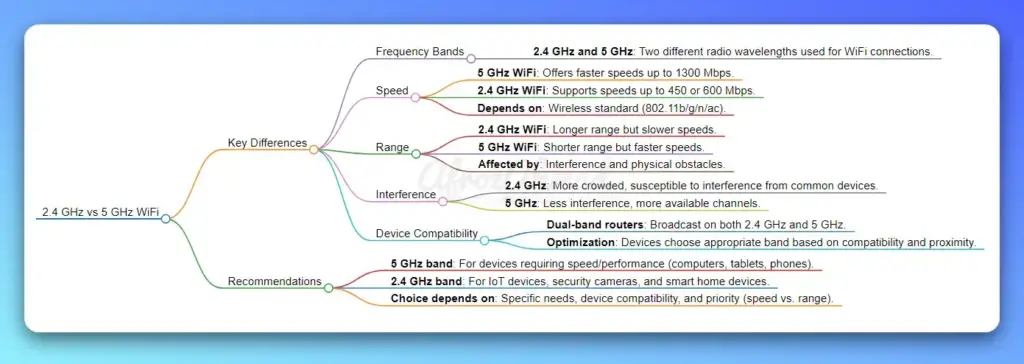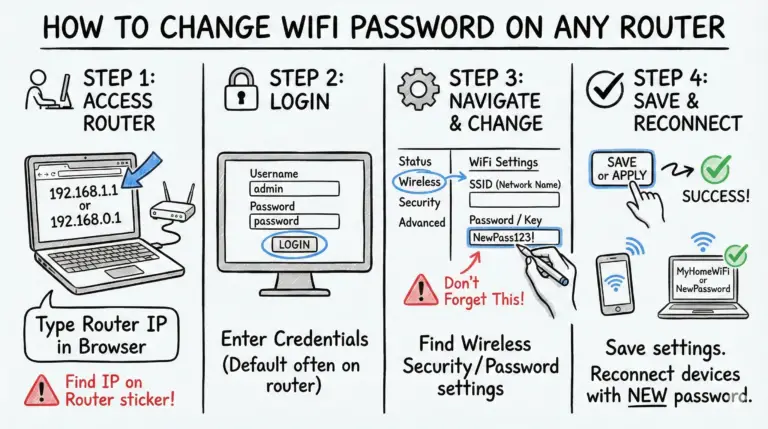Have you ever connected to a Wi-Fi network and found the speed to be frustratingly slow or inconsistent? Or maybe you’ve noticed certain devices in your home struggle to maintain a solid wireless connection. Issues like these are often the result of using the wrong WiFi band (2.4 GHz vs 5 GHz) for your needs.
2.4 GHz offers a longer range but slower speed, while 5 GHz provides faster connections with less interference and lower range.
Stay tuned to learn more about the key differences between these two Wi-Fi frequencies and how to choose the right one for your needs. Keep reading for valuable insights to enhance your wireless connectivity experience.

Key Takeaways – 2.4 GHz vs 5 GHz
When it comes to choosing between the 2.4 GHz vs 5 GHz Wi-Fi bands, there’s no definitive “better” option. The right band depends on your wireless environment and connectivity needs.
2.4 GHz Wi-Fi offers better range and penetration through walls, but provides slower speed. It’s also prone to more interference from other household devices.
5 GHz Wi-Fi delivers faster speeds, but has less range and wall penetration capabilities. It operates on less crowded frequencies, so it handles interference better.
Here are the essential takeaways:
- Connect stationary, high-bandwidth devices to faster 5 GHz Wi-Fi
- Connect mobile devices that roam to 2.4 GHz for better range
- Leverage dual or tri-band routers to enable and separate both 2.4 and 5 GHz bands
- Tweak router settings like channels to optimize signals on both bands
- There’s no one-size-fits-all answer – choose bands based on your specific needs
Here are some of my favorite Tri-band routers on which you can easily separate 2.4 and 5 GHz bands.



By understanding the pros and cons of 2.4 GHz vs 5 GHz Wi-Fi, you can make the best choice for each of your devices’ connections. Your network will be faster and more reliable as a result.
A Quick Background on WiFi Signals
Wi-Fi signals operate on specific radio frequency bands that allow devices to communicate wirelessly. The numbers 2.4 and 5 refer to the operating frequency of the Wi-Fi signal, measured in gigahertz (GHz).
- 2.4 GHz = 2.4 billion cycles per second
- 5 GHz = 5 billion cycles per second
So a 5 GHz signal oscillates at a faster rate than a 2.4 GHz signal. This allows more data to be transmitted per second, enabling faster connection speeds.
However, there are tradeoffs to consider with each frequency band, which we’ll explore in this article.
2.4 GHz Wi-Fi Band Overview
The 2.4 GHz band has been used for Wi-Fi connectivity since 1997. It offers fairly good range and coverage capabilities for most homes and offices, which has made it the popular go-to option for years.
Speed
- Max speed depends on Wi-Fi standard, but typically up to 600 Mbps
- Great for basic web browsing, email, social media
Range & Coverage
- Effective range up to 150 feet indoors and 300 feet outdoors
- Better penetration through solid objects like walls and floors
Device Support
- Supported by all modern Wi-Fi devices
Interference Potential
- Higher – many household devices use this band like baby monitors, Bluetooth, microwaves
So while 2.4 GHz Wi-Fi certainly has some advantages, it does face challenges from a performance perspective. Interference and network congestion can hamper connectivity quality.
5 GHz Wi-Fi Band Overview
The 5 GHz band entered mainstream use in 2014 with the 802.11ac standard. It delivers substantially faster speeds by operating on less crowded frequencies. However, it does have shorter-range limitations.
Speed
- Max speed over 1300 Mbps depending on standard
- Ideal for high bandwidth tasks like 4K streaming, gaming
Range & Coverage
- Effective signal range of 100 feet indoors
- Poorer ability to penetrate solid objects
Device Support
- Supported on most modern devices after 2014
Interference Potential
- Lower than 2.4 GHz band
- Used by fewer device types
With faster potential speeds and less interference, the 5 GHz band solves some of the performance challenges of the 2.4 GHz spectrum. However, users trade off some signal range in the process.
See also: Best Channel for 5GHz WiFi
Key Factors in Choosing a Wi-Fi Band
So which frequency band should you use? There’s no definitive answer – it depends on your specific needs and environment. Here are some key considerations:
1. House/Apartment Size and Layout
- Smaller spaces → 5 GHz
- Larger spaces → 2.4 GHz
In a small apartment, the shorter range of 5 GHz Wi-Fi may sufficiently cover all rooms. But a larger home might require a 2.4 GHz signal to push connectivity to the edges.
Also consider your floorplan and construction. Lots of solid walls block signals, so adjusting bands based on room-to-room performance makes sense.
2. Device Types Used
- Mobile devices → 2.4 GHz
- High bandwidth devices → 5 GHz
The type of device connecting to Wi-Fi impacts your choice. Most mobile devices like smartphones rely more on range and penetration than extreme speed. Opting for 2.4 GHz ensures better connectivity.
Whereas streaming devices, gaming consoles, and computers benefit from 5 GHz for high-bandwidth activities like 4K video and online gaming.
3. Your Bandwidth Needs
- Light use ― web, email → 2.4 GHz
- High bandwidth ― streaming, gaming → 5 GHz
The applications you use also matter. Light activities like checking email and social media rarely need faster 5 GHz speeds. You’ll enjoy solid performance on 2.4 GHz.
However, streaming Netflix or playing Call of Duty requires robust, uninterrupted bandwidth in the 100+ Mbps range. In these cases, 5 GHz is likely the better fit.
4. Congestion and Interference Potential
- Converted apartment building → 5 GHz
- Rural environment → 2.4 GHz
Consider nearby Wi-Fi sources when choosing bands. In an apartment building, the 2.4 GHz spectrum is likely overflowing with interfering signals from closely packed routers and IoT devices. This congestion bogs things down.
In rural areas with fewer Wi-Fi networks, the 2.4 GHz band may deliver solid performance because less airtime contention exists. No need to “upgrade” to 5 GHz.
Key Recommendations
Based on the tradeoffs discussed for 2.4 GHz vs 5 GHz Wi-Fi, what general guidance can we offer?
Use 5 GHz for Stationary, High-Bandwidth Devices
For devices like smart TVs, desktop computers, and gaming consoles that demand lots of bandwidth but don’t move around, connect them to the 5 GHz band whenever possible. These clients will benefit the most from faster speeds and reduced interference.
Use 2.4 GHz for Mobile Devices
Smartphones, tablets, laptops, and IoT gadgets move around frequently, so they need better range and penetration. The 2.4 GHz band allows you to roam further from the wireless router without disconnections. It’s the best option for mobility.
Leverage Dual-Band Routers
Investing in a dual or tri-band router that supports both 2.4 and 5 GHz allows you to segment devices based on their needs. With both bands available, you can fine tune connections on a device-by-device basis.
Adjust Router Settings for Performance Gains
Tweaking certain router settings can further optimize Wi-Fi signals on both bands:
- Change channels to avoid congestion from neighboring Wi-Fi networks
- Enable band steering to nudge capable devices toward 5 GHz for better speeds
- Set client device priorities to ensure important devices get the bandwidth they need
Final Thoughts
Understanding whether to use 2.4 GHz vs 5 GHz Wi-Fi doesn’t need to be complicated. While both frequency bands have their merits, usually it makes sense to connect stationary, high-bandwidth devices to the faster 5 GHz signal whenever possible. Reserve 2.4 GHz for mobile devices where range and penetration matter more.
Investing in a dual or tri-band router and optimizing settings provides the flexibility to segment device connections based on their needs. Taking a few minutes to properly organize your network goes a long way to maximizing performance and eliminating frustration from intermittent connectivity hiccups.
If you experience consistent issues with lag, buffering, or disconnects, don’t immediately blame your internet provider. Carefully examine your Wi-Fi environment and objectively assess devices struggling with solid connectivity. An informed adjustment to Wi-Fi bands or router settings often alleviates problems.
Understanding the nuances of 2.4 GHz vs 5 GHz empowers you to build a robust wireless environment tailored precisely to your devices and usage patterns. Now get out there and start fine tuning those networks!
Frequently Asked Questions
Still have some questions? Here we tackle some frequently asked questions about 2.4 GHz vs 5 GHz Wi-Fi.
Why does my Wi-Fi slow down sometimes?
There are a few common culprits for Wi-Fi slowing down:
- Excessive bandwidth usage – Too many high bandwidth tasks like streaming occurring at once
- Interference or congestion in the Wi-Fi bands from external sources
- Outdated hardware like an old router, modem, computer network card, etc.
In many cases, switching to the 5 GHz band or upgrading hardware resolves speed issues. Checking for interference sources and setting client device priorities can also help maximize your available bandwidth.
Do all devices support 5 GHz Wi-Fi?
Modern wireless devices produced after 2014 generally support both 2.4 GHz and 5 GHz Wi-Fi bands. However, some older gadgets may still be 2.4 GHz only. Before purchasing a new router or network upgrade, double check what bands your devices use to ensure compatibility.
What’s the range difference between bands?
2.4 GHz Wi-Fi generally provides around 150 feet of indoor range and 300 feet outdoors. 5 GHz Wi-Fi offers approximately 100 feet of indoor signal coverage. So you sacrifice about one-third of range jumping to 5 GHz. Walls and floors degrade signals further.
What devices commonly interfere with Wi-Fi signals?
Baby monitors, Bluetooth gadgets, cordless phones, and microwaves often operate on the 2.4 GHz band, so they can create interference on those frequencies. 5 GHz provides more isolation from common household items. Neighboring Wi-Fi networks also contribute to interference, especially on 2.4 GHz in densely populated environments like apartment buildings.
Is one band more secure than the other?
From a security standpoint, neither band is inherently more secure. Encryption and authentication methods like WPA provide network security, not the underlying frequencies. Both bands offer the same encryption options on modern routers. However, the expanded signal range of 2.4 GHz does allow for more potential eavesdropping at distance.
- How to Configure a Secure Site-to-Site VPN on Cisco Firepower Complete Guide - December 3, 2025
- Jobs for Network Engineers: Roles, Skills & Pay - December 3, 2025
- How to Change WiFi Password on Any Router : The Last Guide You Need - December 1, 2025



